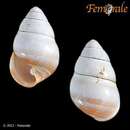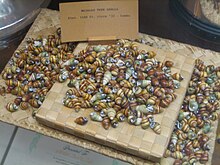pt-BR
nomes no trilho de navegação


Achatinella ist der Name einer Gattung von Schnecken in der Familie Achatinellidae, nachtaktiver, lebendgebärender Baumschnecken, die auf der hawaiischen Insel Oʻahu endemisch sind.
Die bei ausgewachsenen Schnecken meist etwa 2 cm langen Gehäuse sind rechts oder links gewunden und variieren in Form und Farbe. Sie sind in der Regel länglich oder eiförmig und haben eine glatte Oberfläche.
Die Schnecken leben auf Bäumen, wo sie sich vom pilzlichen Bewuchs der Blätter ernähren. Gelegentlich werden die Schnecken auch auf Neophyten gefunden, doch ist unklar, ob auf diesen wachsende Pilze eine ausreichende Lebensgrundlage für die Schnecken bieten. In Gefangenschaft können zumindest einige Arten mit Pilzen gefüttert werden, die auf dem Myrtengewächs Metrosideros polymorpha oder auch auf Maismehl-Agar wachsen.
Die Schnecken sind wie andere Lungenschnecken Zwitter, die sich mit ihren Penissen gegenseitig begatten. Die Jungschnecken werden lebend geboren.
Als die Achatinella-Schnecken noch häufig waren, wurden sie wegen ihrer Gehäuse gesammelt, die als Schmuck für Lei verwendet wurden.
Schnecken der Gattung Achatinella leben ausschließlich auf der hawaiischen Insel Oʻahu. Auf Grund ihrer niedrigen Reproduktionsrate und ihres langsamen Wachstums reagieren sie empfindlich auf Störungen. Die Baumschnecken waren früher häufig und wurden in hawaiischen Märchen und Liedern erwähnt. Heute sind von den 40 beschriebenen Arten 16 ausgestorben und alle anderen stark gefährdet. Sie sind durch das Washingtoner Artenschutzabkommen streng geschützt.
Als Ursachen des Rückgangs und Aussterbens der Schnecken werden übermäßiges Sammeln durch Schneckensammler, die Nachstellung durch eingeschleppte Schweine und Ratten, die Rodung der Wälder sowie invasive Pflanzenarten wie Clidemia hirta und Dicranopteris linearis angegeben, die das Nachwachsen der für die Schnecken unentbehrlichen Futterbäume verhindern. Auch die eingeführte Ameisenart Pheidole megacephala, die Knoblauch-Glanzschnecke (Oxychilus alliarius) und die Rosige Wolfsschnecke (Euglandina rosea) machen Jagd auf Achatinella-Schnecken.
Zur Gattung Achatinella gehören 40 anerkannte Arten, davon 16 ausgestorbene, die in drei Untergattungen gestellt werden:
Untergattung Achatinella
Untergattung Bulimella
Untergattung Achatinellastrum
Achatinella ist der Name einer Gattung von Schnecken in der Familie Achatinellidae, nachtaktiver, lebendgebärender Baumschnecken, die auf der hawaiischen Insel Oʻahu endemisch sind.
Achatinella is a tropical genus of colorful land snails in the monotypic Achatinellidae subfamily Achatinellinae. Species are arboreal pulmonate gastropod mollusks with some species called Oʻahu tree snails or kāhuli in the Hawaiian language.
Achatinella species are all endemic to the island of Oahu in Hawaii, and all remaining extant species are endangered. They were once abundant and were mentioned extensively in Hawaiian folklore and songs, and their shells were used in lei and other ornaments.
Many of the species are sinistral or left-handed chirality in their spiral shell coiling, whereas most gastropod shells are dextral, with a right handed spiral.
There were 41 species[1] of Achatinella endemic to the Hawaiian island of Oʻahu, though only 13 species survive. Some species have less than 50 remaining individuals, and others have +300; many species fall in between.
All 13 species are listed under United States federal legislation as endangered. The IUCN lists a number of Achatinella species as extinct and the remainder as critically endangered. The main cause of decline has been attributed to over collection. In addition, invasive species such as rats, Jackson's chameleons, and the highly predatory snail Euglandina rosea have been involved in the extinctions and declines of the native tree snails.[3]

Achatinella species shells are diverse in patterns, colors, and shapes, but all average about 0.75 in (1.9 cm) in length. Most have smooth glossy, and oblong or ovate shells which show a variety of colors, including yellow, orange, red, brown, green, gray, black, and white.
There are three recognized subgenera within the genus Achatinella.[4] Subgenera are distinguished according to shells characteristics only.
Genus Achatinella Swainson, 1828: The dextral or sinistral shell is imperforate or minutely perforate, oblong, ovate or globose-conic; smooth or longitudinally corrugated, with only weak traces of spiral sculpture. Shell color is in spiral bands or streaks in the direction of the growth lines. The lip is simple or thickened within and sometimes slightly expanding. The columella bears a strong callous fold. Type species of the genus Achatinella is Achatinella apexfulva (Dixon).[4]
Subgenus Bulimella Pfeiffer, 1854: Shell shape is oblong-conic or ovate. The spire is obtuse, rounded or convexly-conic near the apex. The outer lip is thickened by a strong callous rib within the aperture (except in Achatinella abbreviata and Achatinella lila). Type species of the subgenus Bulimella is Achatinella byronii Newcomb.[4]
Subgenus Achatinellastrum Pfeiffer, 1854: The shell is imperforate, ovate-conic or oblong-conic and smooth. The embryonic whorls are not flattened. The outer lip is thin or only slightly thickened within the apex but not expanded. These are the most generally distributed of the Achatinella species and show a prolific area of intergrading color patterns. Type species of the subgenus Achatinellastrum is Achatinella stewartii (Green, 1827).[4]
These snails live in trees. Currently they are only found in mountainous dry to moist forests and shrublands above 1,300 ft (400 m). Most individuals spend their entire life on just one tree.
These tree snails are nocturnal, and feed by grazing fungus which grows on the surface of native plant leaves.
Although these tree snails are occasionally found on introduced plants, it is unknown whether or not the fungus which grows on these plants can provide long-term support for healthy breeding populations of these snails.
In captivity Achatinella feed on fungus growing on leaves of Metrosideros polymorpha. They also feed on cornstarch, which can be spread in terraria with water and on cultures of sooty mold grown on laboratory agar. In captivity, cuttlebone is used as a source for calcium.[4]
Adult snails are hermaphroditic (having both male and female reproductive organs) and can live for many years. These are live bearing snails (give birth to live snails instead of laying eggs).
Because growth rate and fertility are very low, these snails are especially vulnerable to loss of individuals through human collection, through predation, or because of other disturbances.
The most serious threats to the survival of Oʻahu tree snails are predation by the introduced carnivorous snail Euglandina rosea, by rats (Rattus exulans, Rattus norvegicus, Rattus rattus),[1] and loss of habitat due to the spread of non-native vegetation into higher elevation forests.
An additional threat is Jackson's chameleon (Trioceros jacksonii) that were introduced to Hawaii in the early 1970s are a serious threat to Achatinella, because the chameleons directly prey on them and other snails species.[1][2] Other predators of Achatinella include the land planarian Platydemus manokwari.[1]
According to Ancient Hawaiian folklore, the kāhuli are known as the pūpū kani oe, which translates to "shell that sounds long" or the "singing shell". They are believed to be able vocalize and sing at night. Experts have attributed this association to the chirping of crickets at night when the snails are active. Native Hawaiians used the shells of the snails to create kahuli shell lei and their status as coveted souvenirs in the 19th-century may have contributed to the decline of the species. The summer palace of King Kamehameha III was called Kaniakapupu ("the singing of the land shells") because of the many snails which once inhabited the area during his lifetime.[5][6]
There are 41 species in the genus Achatinella:[4]
This article incorporates public domain text (a public domain work of the United States Government) from reference.[4] [7] [8] [9]
Achatinella is a tropical genus of colorful land snails in the monotypic Achatinellidae subfamily Achatinellinae. Species are arboreal pulmonate gastropod mollusks with some species called Oʻahu tree snails or kāhuli in the Hawaiian language.
Achatinella species are all endemic to the island of Oahu in Hawaii, and all remaining extant species are endangered. They were once abundant and were mentioned extensively in Hawaiian folklore and songs, and their shells were used in lei and other ornaments.
Many of the species are sinistral or left-handed chirality in their spiral shell coiling, whereas most gastropod shells are dextral, with a right handed spiral.
Achatinella es un género de caracoles arborícolas tropicales de la familia Achatinellidae.
Este género vive en Hawái, y todas sus especies están en peligro de extinción o extintas. Alguna vez fueron abundantes. Eran mencionados en el folclor hawaiano y sus conchas eran usadas para hacer lei y otros ornamentos.
Se registraron 50 especies[1] de Achatinella, todas endémicas de la isla de Oahu.
Las 40 especies aparecen en la legislación federal de Estados Unidos como especies en peligro. La UICN muestra algunas de estas especies como extintas y el resto como en peligro crítico.
Estos caracoles viven en árboles. Actualmente solo son encontrados en los bosques y matorrales secos a húmedos, en la montaña, sobre 400 m.
Estos caracoles son nocturnos, y se alimentan de hongos que crecen en la superficie de las hojas de las plantas nativas.
Aunque estos caracoles han sido encontrados ocasionalmente en plantas introducidas, se desconoce si los hongos que crecen en estas plantas pueden ser proveer de apoyo a largo plazo para la crianza de poblaciones saludables de caracoles.
En cautiverio Achatinella se alimenta de los hongos que crecen en las hojas de Metrosideros polymorpha. También se alimentan de maicena, la que puede colocarse en terrarios con agua y cultivos de fumagina en agar. En cautiverio puede usarse hueso de sepia como una fuente de calcio.[1]
Son hermafroditas, es decir que tienen órganos reproductivos de macho y hembra, y vivien muchos años. Estos caracoles dan a luz caracoles vivos en vez de poner huevos.
Ya que su velocidad de crecimiento y fertilidad son muy bajas, estos caracoles son especialmente vulnerables a la pérdida de individuos por los coleccionistas humanos, la depredación u otros problemas.
La amenaza más seria para la supervivencia de estos caracoles es el Euglandina rosea, un caracol introducido y carnívoro, depredación por ratas y pérdida de hábitat por la expansión de la vegetación introducida al bosque de mayor altitud.
Hay 40 especies en el género Achatinella:[1]
subgénero Achatinella
subgénero Bulimella
subgénero Achatinellastrum
Achatinella es un género de caracoles arborícolas tropicales de la familia Achatinellidae.
Este género vive en Hawái, y todas sus especies están en peligro de extinción o extintas. Alguna vez fueron abundantes. Eran mencionados en el folclor hawaiano y sus conchas eran usadas para hacer lei y otros ornamentos.
夏威夷蝸牛是一類色彩鮮艷的蝸牛,屬於小瑪瑙螺屬。牠們分佈在夏威夷,除了9個現生種以外,其餘物種均已滅絕;所有現生種亦屬瀕危物種。
夏威夷蝸牛的數量曾經很豐富。在夏威夷的傳說及歌曲中都有提及牠們,牠們的殼可以用來製成發光花環或其他裝飾品。牠們的殼大都是左旋的,而其他腹足綱的殼很多時都是右旋的。
夏威夷蝸牛的殼有可同的顏色、款式及形狀,但一般都長2厘米。牠們的殼表面平滑及有光澤,可以呈長形或卵形,顏色包括黃色、橙色、紅色、褐色、綠色、灰色、黑色及白色。
夏威夷蝸牛是夜間活動,主要吃葉子上生長的真菌。雖然有時會在入侵的植物上見到牠們,但長在這些植物上的真菌是否有害則不明。
成年的夏威夷蝸牛是雌雄同體的,可以有很多年的壽命。牠們會產下蝸牛,而非產卵。
約有40種的夏威夷蝸牛分佈在夏威夷的歐胡島內。牠們棲息在樹上。現時只有在高於海拔400米山區的森林及叢林中見到牠們。
所有40種夏威夷蝸牛都在美國列為瀕危物種。世界自然保護聯盟將一些夏威夷蝸牛列為滅絕,而其他的則為極危。
由於夏威夷蝸牛的生長率及成熟期很低,牠們易受到不同的威脅,包括人類採集、其他動物的掠食或影響。
對夏威夷蝸牛最大的威脅是掠食牠們的玫瑰蝸牛及大家鼠,與及失去棲息地(棲息地破壞)等。
2019年1月9日, 已知世上最後一隻金頂夏威夷樹蝸「孤獨喬治」逝世,終年14歲。[1]
夏威夷蝸牛是一類色彩鮮艷的蝸牛,屬於小瑪瑙螺屬。牠們分佈在夏威夷,除了9個現生種以外,其餘物種均已滅絕;所有現生種亦屬瀕危物種。
夏威夷蝸牛的數量曾經很豐富。在夏威夷的傳說及歌曲中都有提及牠們,牠們的殼可以用來製成發光花環或其他裝飾品。牠們的殼大都是左旋的,而其他腹足綱的殼很多時都是右旋的。